
Their lyrical Latin name (euphorbia) and guttural common name (spurge) are indicative of the dual nature of
euphorbias — elegant yet tough. The ones discussed here are the hardy perennial types, but the genus also includes
succulents like pencil cactus, tropicals like poinsettia and shrubs with wicked-sharp spines.
Swipe to view slides
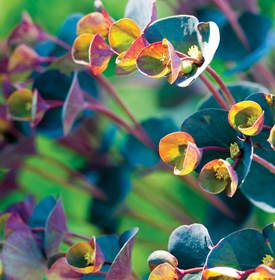
Photo by: Rob Cardillo.
1. ‘BLACKBIRD’
Compact mounds of deep-purple leaves on reddish stems with bright-yellow heads of flowers — talk
about a dramatic color combo! Euphorbia ‘Blackbird’ keeps to a neat 1 to 2 feet tall and wide,
making it a fit for small borders and containers. The rich foliage color is darker (almost black) in full sun
and stays strong all season; in warmer zones it can even be evergreen. Clusters of densely packed blooms
appear in spring. Zones 6-9.
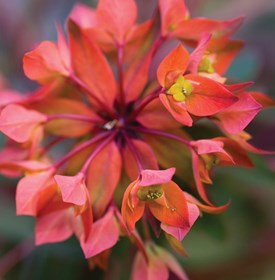
Photo by: Andrea Jones.
2. ‘DIXTER’
We have noted British garden writer Christopher Lloyd to thank for this fiery spurge. There’s never
a dull moment with Euphorbia griffithii ‘Dixter’ (named for Lloyd’s home Great Dixter).
Coral shoots emerge in spring and segue into reddish-bronze stems and dark-green foliage flushed with coppery
red. Burnt-orange heads of flowers sizzle all summer. This spurge likes a bit of shade and moist soil. Zones 5-9.
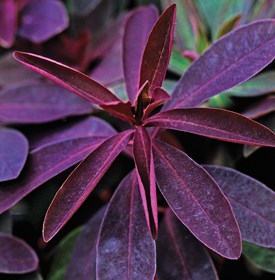
Photo by: Andrea Jones.
3. ‘CHAMELEON’
Maroon-purple leaves form a mound 1 to 2 feet tall, making a snappy backdrop for the yellow-green flowers.
Euphorbia dulcis ‘Chameleon’ can seed itself about the garden, so as a preventive it can be cut
back hard after flowering, which also promotes a flush of new foliage. Older plants can get leggy, but
division is easy in early fall or spring. Sometimes called swamp spurge, ‘Chameleon’ is partial
to moist, rich soil. Zones 4-9.
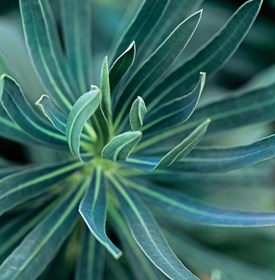
Photo by: Andrea Jones.
4. MEDITERRANEAN SPURGE
A shrubby species found in the Mediterranean region on rocky hillsides, open woods and along roadsides,
Euphorbia characias comes by its drought and heat tolerance naturally. Blue-green leaves spiral up reddish,
downy stems. The foliage is denser toward the tops of the stems, leaving the bases bare, giving the plant an
architectural vibe. Big clusters of chartreuse flower heads last from spring to summer. This is a short-lived
perennial, but it reseeds. Zones 7-10.
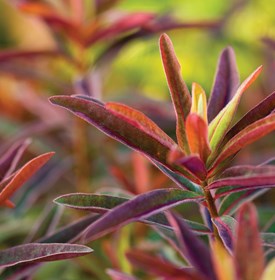
Photo by: Rob Cardillo.
5. ‘BONFIRE’
Aptly named, Euphorbia polychroma ‘Bonfire’ bursts onto the scene in spring with foliage that
mixes green, yellow and orange, changing to crimson, burgundy and mahogany for the summer-through-fall show — a great contrast for the chartreuse-gold blooms. Its neat, mounded form lends itself to the front of the
border or a container. Takes full sun in the North, part shade in the South. Cushion spurge benefits from a
late-summer cutback and from division every few years. Zones 5-9.
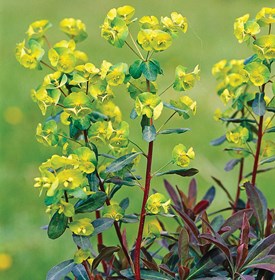
Photo by: Rob Cardillo.
6. ‘GOLDEN GLORY’
A cultivar of wood spurge, Euphorbia amygdaloides, ‘Golden Glory’ sports chrome-yellow flowers
atop 1- to 2-foot domes of reddish-green foliage and red stems in the spring. Leaf color can hold true even
through the winter in warmer areas. Full sun keeps the foliage nice and dark. Zones 6-10.
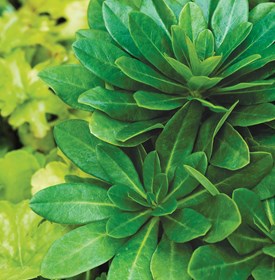
Photo by: Rob Cardillo.
7. ROBB’S SPURGE
Ask any gardener to name the toughest site, and the answer will be dry shade. But Euphorbia amygdaloides
var. robbiae can solve the problem. Slow to spread, it forms an evergreen groundcover 1 to 2 feet tall of
deep green, lustrous leaves. Chartreuse flower heads appear in late spring and last for months. In moist,
rich soil it spreads faster. Zones 5-7.
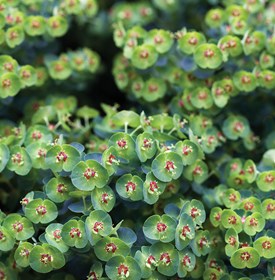
Photo by: Chelsea Stickel.
8. ‘TINY TIM’
With the tongue-twisting official name of Euphorbia martini ‘Waleutiny’, it’s no wonder
this cushion spurge has acquired a much cuter appellation. Looking like a Koosh Ball, ‘Tiny Tim’
forms a perfect 1-foot dome of narrow blue-green leaves and a cloud of greenish-yellow bracts cupped under
little red flowers. Unlike many spurges, this one continues to bloom throughout the season. Zones 6-8.
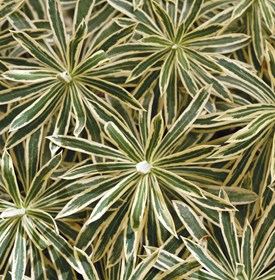
Photo by: Chelsea Stickel.
9. ‘TASMANIAN TIGER’
Discovered as a seedling of Euphorbia characias in a garden in Tasmania, this phenomenal spurge has both
variegated leaves and flowers, combining blue-green with creamy white. Upright stems are a forest of linear
leaves, forming a dense shrubby mound. In spring through early summer, large heads of flowers hover on 2- to
3-foot stems, pale yellow and cream, with small green bow-tie centers. Evergreen where winters are mild. Zones 6-9.
Hardy spurges have become hugely popular in perennial borders across the continent and in Europe, their stout
mounds of leafy stems, like so many oversize bottlebrushes, filling a shrubby role, though with predictable sizes and
tidy forms. Newer varieties have richly colored leaves and flower heads, in burgundy, copper, creamy-white striped,
eggplant purple and icy blue-green.
The flowers are an unusual arrangement and one of the commonalities of the euphorbia family. Most obvious in the
flashy display of poinsettias, the showy parts are actually not flowers but modified leaves called bracts. The real blooms are tiny and distinctly
non-flowery looking. One benefit of having bracts is that the floral heads continue to be showy long after the
flowers themselves have done their thing. Another common factor among euphorbias is the milky sap that runs through
their veins, which is poisonous and a skin irritant. But what makes them toxic also makes them deer resistant—a
big bonus. Add to that drought and heat tolerant, long blooming and low maintenance, and you’ve got a nonpareil
perennial.
Growing Euphorbia
Care:
Euphorbias are easy and tough, with few problems. Some are short-lived (even so, totally worth growing) and should be
divided or propagated every two to three years, either in early fall or spring. Many benefit from being cut back
hard, at least by one-third, after flowering is finished. This keeps any free-seeders from gaining the upper hand and
encourages a flush of new fresh foliage. Wear gloves when handling euphorbias, and quickly wash off any milky sap
that gets on your skin, as it’s a strong irritant. The sap also makes spurges poisonous, so be aware if you
have children and pets, though I’ve had euphorbias and garden cats coexist for years without incident — perhaps
the plants’ skunky smell keeps them from seeming like a tasty treat.
Zones:
Perennial euphorbias vary in hardiness, particularly as concerns their northern edges, so check individual entries
for the plants covered here. Some types are evergreen in southerly zones but are only root hardy farther north.
Exposure:
Euphorbias in general are sun lovers, though some will tolerate partial shade. Those with deep-purple or reddish
foliage will have more-intense coloring if planted in full sun. A very few types actually prefer at least dappled
shade, while others can thrive in bright sun in the North but need part shade in the blinding light of the South.
Soil:
One of the main benefits of growing spurges is their drought tolerance, so good drainage is key, though a few, such
as
E. griffithii
‘Dixter’ and
E. dulcis
‘Chameleon’, do prefer more moisture than others. Euphorbias are also not picky about soils, and most can
handle sandy and average situations. For those types that tend to run and spread, fertile soils could encourage them
to expand beyond their boundaries, so keeping things lean lends control. But if you want your
E. amygdaloides var. robbiae
to cover more ground faster, rich organic soil will kick things off.
RELATED:
Foliage Plants
Poisonous Plants